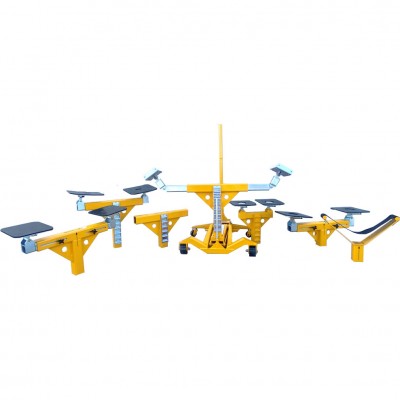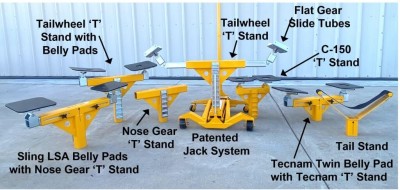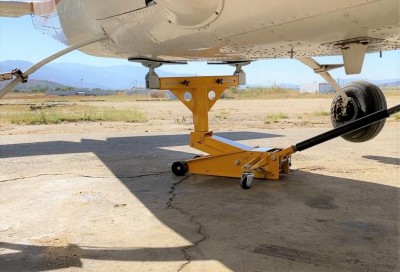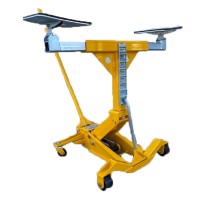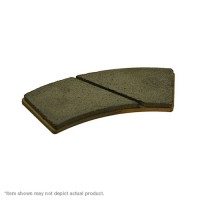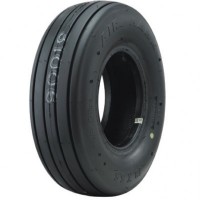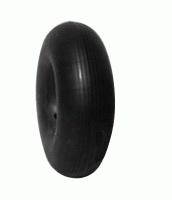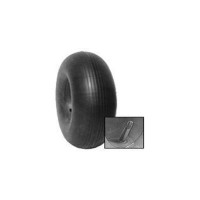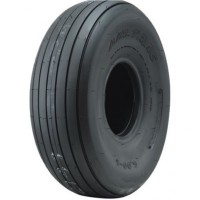1-877-795-2278 | info@aircraftspruce.ca
Aircraft Spruce Canada
Brantford, ON Canada
Corona, CA | Peachtree City, GA
Chicago, IL | Wasilla, AK
Aircraft Spruce Canada
Brantford, ON Canada
Corona, CA | Peachtree City, GA
Chicago, IL | Wasilla, AK
THE AVIATION SUPERSTORE FOR ALL YOUR AIRCRAFT & PILOT NEEDS | 877-795-2278
Aircraft Jacking Solutions Tail Stand for Tailwheel Aircraft
$536.00/Each
+$312 Aircraft Jacking Crate Fee
Part# 12-05616
MFR Model# 4360-7
MFR Model# 4360-7
| Product Type | Description | Eligiblity | Part Number |
|---|---|---|---|
| Subcomponent / Accessory | Tail Wheel Stand | -- | 12-05616 |
Overview
|
This simple, safe, and efficient design allows for quick servicing or repair of aircraft wheel assemblies and main gear security. The new design allows both nose gear and tailwheel aircraft to be raised by the landing gear with lift pads placed at the upper portion of the gear lags. The latter allows both wheels to be lifted together creating a stable much safer working environment. Built-in safety stops prevent unplanned lowering of the jack. The cushioned Belly Pad lifting option allows aircraft to be lifted from below the gearbox bulkheads. Lifting the aircraft from below allows the mechanic to inspect the security of the upper gear at the gearbox and to investigate any play or movement.
|
Aircraft Compatibility List
- Citabria
- Sling Aircraft
- Tecnam Aircraft
- Cessna 120 Tailwheel
- Cessna 140 Tailwheel
- Cessna 150 Nosegear
- Cessna 170 Tailwheel
- Cessna 172 Nosegear
- Cessna 180 Tailwheel
- Cessna 182 Nosegear
- Cessna 185 Tailwheel
- Cessna 206 Nosegear
FAQs
- What maintenance activities/repairs can I perform while using this Jack?
- The jack is intended for the purpose of servicing wheel bearings, replacing tires, replacing brake pads, replacing landing gears, and verifying torque of main gear attach bolts and gear shims are tight and secure. Some of these activities are normally difficult or impossible to do with other jacking systems.
- When is it better to use the belly pad systems vs the flat gear system?
- The belly pad system allows for the gear legs to be changed and thorough inspection of gearbox main bolts on tailwheel aircraft. These activities would not be possible using other jacking systems.
Both systems will safely raise the aircraft. It’s up to personal preference on how the owner/user wants to utilize the Coppycog Jacking System.
- How do I ensure the Belly Pad system will not damage the skin of my aircraft? It seems like a lot of load on a small surface area.
- The area where the belly pads are placed is one of the most robust areas of the aircraft since this is where the landing forces are absorbed in the fuselage. This jack has successfully been used to lift hundreds of aircraft and no damage has been reported.
- What is the Jack’s lifting capacity?
- The lifting capacity of the entire jack system including the use of Flat Gear or Belly Pad attachments in 3,800 lbs. As a point of reference, the gross weight of a Cessna 206 is 3,300 pounds.
- Is there a warranty?
- Yes, all lift components above the floor jack have a lifetime warranty to the original owner. The floor jack may need “O” ring replacement or minor maintenance from time to time. Parts for this and or similar work have a lifetime warranty to the original owner.
- How do I ensure the Coppycog Jack doesn’t lower on its own or unexpectedly?
- The jack’s safety stop system should always be used to prevent potential slow bleed down of the jack or abrupt lowering by an unauthorized person attempting to lower the jack during routine wheel maintenance.
- Is it OK to enter the aircraft while it’s raised?
- No, the jack is not designed to support excessive side loads or movements that may occur.
- Is it safe to crawl under the aircraft while raised?
- No, you should never place your body and any part under a suspended load. The jack is designed with a safety stop mechanism that should always be utilized when lifting your plane. The actuator lever/knob for engaging this safety system was placed near the pump handle to ensure the operator is kept out of harm’s way. Safety first!!
- Will the jack’s lift pads scratch paint or damage my brake lines?
- No, as long as the lift pads are both centered under the flat gear legs the nylon inserts will not scratch or chip paint. They are designed to slide into position as the aircraft is raised and will not pinch or damage the brake lines.
- I’ve noticed the jacking action seems to only occur when the pumping handle is near the end of its stroke.
- This is due to a low hydraulic fluid level in the jack. Simply remove the floor jack cover located forward of the pump handle. There is a small rubber plug on the top of the jack cylinder. Remove the plug and add hydraulic fluid until it can be seen at the top of the fill hole.
- While using the belly pad attachments to raise my aircraft, I’m concerned that existing oil on the belly will allow the pads to slip.
- It’s always a good habit to wipe off any excess oil in the area where the belly pads will be contacting the aircraft belly. The protruding rivet heads of your aircraft will slightly embed into the ¼” thick rubber pad attached to the lifting plate and do an excellent job of eliminating slipping potential.
- If I’m removing the main gear legs with the aircraft raised and supported by your jack. Are there any additional precautions I should take or consider during this operation?
- Always engage the jack’s safety stop system. If this activity will span over days or weeks, it’s a good idea to secure the aircraft at each tie-down ring to floor-mounted tie-downs (if available) or ballast of some sort.
- I have a 1960 C-180. How close to the fuselage should the gear leg lift pads be placed?
- Regardless of type, the upper portion of the gear leg pads should be equally spaced from one another and held roughly 2” to 3” from where the gear legs enter the fuselage.
- I’ve noticed while using the jack one wheel always comes off the ground first. Do you have any advice on how to minimize this?
- Initial jack set up before to lifting is critical. Always center the jack “T” stand directly below the centerline of the aircraft belly. There is typically a row of rivets running tail to nose in this area. Be sure each slide tube is extended equally as indicated by the stamped hash mark and number on each slide tube. Beyond that, ensure the fuel loads are equal. This can be achieved by placing the aircraft fuel selector on both (is so equipped) and over a short time will automatically equalize loads.
- How is the best way to address an out of balance situation after the aircraft is raised?
- This condition is somewhat normal. First, ensure the jack is centered under the aircraft and both slide tubes are equally extended and locked into place. Lift pads should be contacting the gear legs equally from one to another. Under normal conditions, a weight (5-gallon bucket with “S” hook and ballast added) can be hung from the opposite wing tie-down ring. This will raise the heavy wing condition caused by unbalanced fuel, installed equipment, etc.
- Can the jack be used outdoors to raise my airplane?
- Extra caution should be used when using the jack outside. Factors to consider are; wind gusts, sloping terrain, and prop blast, just to name a few.
Documents
In The Box
- Copy of Receipt
- Operating Instruction
- Safety and Use Procedure
- Card stating how to initially bleed hydroloic pump
- Thanks you card
Q&A
Please note, Aircraft Spruce Canada's personnel are not certified aircraft mechanics and can only provide general support and ideas, which should not be relied upon or implemented in lieu of consulting an A&P or other qualified technician. Aircraft Spruce Canada assumes no responsibility or liability for any issue or problem which may arise from any repair, modification or other work done from this knowledge base. Any product eligibility information provided here is based on general application guides and we recommend always referring to your specific aircraft parts manual, the parts manufacturer or consulting with a qualified mechanic.
Q: Will this also work with Cessna 195?
Yes, the tailwheel jack, part # 12-05611 will work with the Cessna 195.

 Aircraft Spruce Canada
Aircraft Spruce Canada
